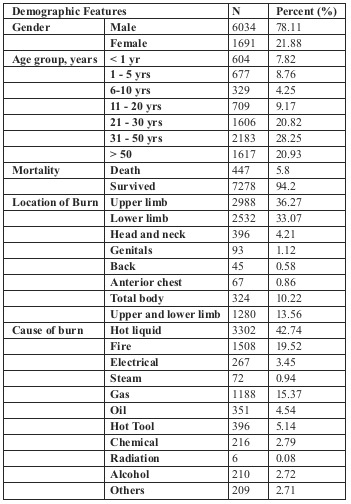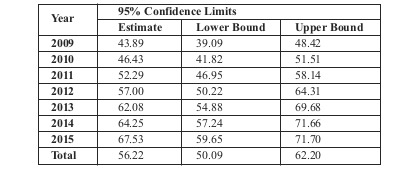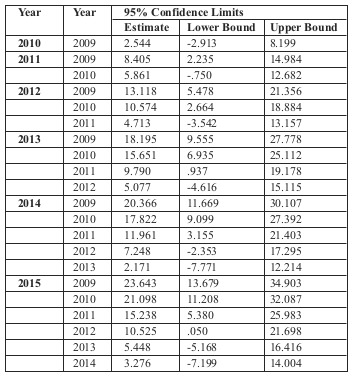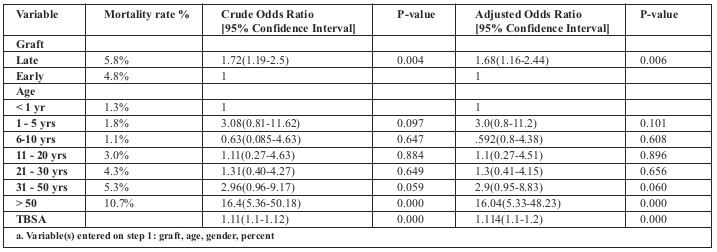Summary
Burning is a major health challenge in all societies. In this descriptive cross-sectional study, health information about hospitalized burn patients was extracted from the hospital information system from April 2009 to February 2015. Logistic regression method was used to identify risk factors and mortality predictors. Lethal area index (LA50) was investigated to evaluate the quality of annual hospital medical care. A total of 7725 patient medical files were examined. Mean age of the patients was 32.3±22.5 years old. The most common cause of burning accidents was hot liquids. Mean percentage of total body surface area was 15.8±17.9%. The most and the least common affected areas were upper parts and posterior thorax, respectively. Total calculated LA50 was 56.22 (CI95% = 50.09-62.20). This index was 43.89%, 46.43%, 52.29%, 52.29%, 57.00%, 62.08% and 67.53% annually from 2009 to 2015, respectively. There was a statistically significant difference with regards to mortality rate in the different age groups, higher-degree burns, burn location and burn causes. Analysis of mortality predictors in a model adjusted by age and sex showed that old age (p<0.0001), inhalational injuries (p<0.0001) and burn percentage (P<0.0001) were the three mortality predictors in the multiple logistic regression model. The relationship between early grafting and decreased mortality and increased LA50 was nearly significant in statistical analyses. Burn patient survival rate and annual LA50 had an increasing trend in this hospital. Early grafting surgery seemed to be effective on this trend and decreased mortality risk to a large extent
Keywords: lethal area index, mortality, mean percentage of total body surface area, burn, early grafting surgery
Abstract
La brûlure est dans toutes les sociétés un défi majeur de santé publique. Dans cette étude descriptive transversale, les informations concernant les brûlés hospitalisés ont été extraites du système informatique de l’hôpital entre Avril 2009 et Février 2015. La méthode de régression logistique a été utilisée pour identifier les facteurs de risque et les indicateurs de mortalité. L’index de surface létale (LA 50) fut utilisé pour évaluer annuellement la qualité des soins médicaux à l’hôpital. Un total de 7725 dossiers médicaux de patients a été colligé. L’âge moyen des patients était de 32,3 + ou - 22,5 années. La cause la plus fréquente des accidents de brûlures était les liquides chauds. Le pourcentage moyen de surface corporelle brûlée était entre 15,8 + ou - 17,9 %. Les zones les plus fréquentes, ainsi que les moins étaient respectivement les régions supérieures et les régions postérieures du thorax. Les chiffres de surface létale étaient de 56,22 (CI95% = 50.09 - 62.20). Cet index était 43.89 %, 46.43 %, 52.29 %, 52.29 %, 57.00 %, 62.08 % et 67.53 % par an entre 2009 et 2015. Il y avait une différence statistiquement significative en ce qui concerne le taux de mortalité et les différents groupes selon l’âge, la profondeur des brûlures, leur localisation et leur cause. L’analyse des indicateurs de mortalité dans un modèle adapté en fonction de l’âge et du sexe montre que l’âge (p <0.0001), les lésions par inhalation (p < 0.0001) et le pourcentage de brûlures (P <0.0001) sont les trois indicateurs de mortalité dans les multiples modèles de régression logistique. Le lien entre greffe précoce, diminution de la mortalité, et accroissement de l’index LA 50 était assez significatif dans les analyses statistiques. Le taux de survie des brûlés et le LA 50 annuel avaient tendance à augmenter dans cet hôpital. La greffe précoce semble être effective sur cette évolution et diminue le risque mortel dans une large mesure.
Introduction
Seventy years ago people had few expectations about burn treatments, even in most developed countries. At that time, most patients died due to serious complications of tissue injuries and fluid and electrolyte abnormality.1 Since the 1970s, with breakthrough advances in burn medicine, such as the discovery of broad spectrum and local antibiotics, various serum therapies, improvement in nutritional conditions, equipping hospitals with advanced specialized burn wards, use of modern dressings, burn mortality rate has significantly decreased. 1-3
Nowadays, lethal area fifty percent (LA50) index is extensively used as a quality factor in different studies. LA50 is the burn percentage at which 50 percent of affected patients will die.4 The index is a valuable tool for evaluating the quality of medical care in burn centres. On the other hand, repetitive measurement of this index can show whether the medical care of burn patients has been efficient or not. Also, it can demonstrate the extent of the required renovation and improvement.4-5 Although burn mortality rate is still a demonstrator of resuscitation efficiency and medical care quality, LA50 can predict medical care quality much better.5
According to previous statistics in Iran, 10% of burn patients die annually.6 Burn is the 8th leading cause of years of life lost (YLL) and the 13th leading cause of disability adjusted life years (DALY) in Iran.7 These figures imply the importance of determining predicting factors effective on negative or positive outcomes during the treatment of burn patients. In a study in Rasht (a city in the North of Iran) in 2012, a mortality rate of 8.7% was reported for burn patients.8
In our study, we investigated the quality of medical care for burn patients in this centre through inspection of annual LA50 index trend from 2009 to 2015. We also investigated the effect of early grafting surgery (which has been the main treatment in this centre since 2012) on LA50 trend.
Materials and methods
This retrospective cross-sectional study was carried out in Rasht Velayat Hospital from April 2009 to February 2015. In this study, only the medical history and files of patients with burn injuries at the time of admission and referred to the Velayat Burn Hospital right after burn were investigated. Patients who had been referred to the hospital by other centres after 5 days or more, and those admitted because of elective choices (such as reconstructive surgery) or burn complications (such as burn scar) were excluded from the study.
A checklist was designed for information registration. A trained operator extracted information such as age, sex, burn type, body surface area percentage, burn degree, burn cause, early grafting surgery, duration of hospitalization, clinical outcome and patient survival from the patients’ files and recorded it in the checklist. In addition, LA50 was calculated with linear regression method as a general index for investigation of resuscitation efficiency and annual medical care quality.
Initially, data were analysed using descriptive statistics (prevalence, percentage and mean) with SPSS version 21. Then, linear regression was employed to calculate LA50 and R square. Comparison of burn percentage classified by age group, sex and year was conducted by independent t test and analysis of variance (ANOVA). To compare mortality percentage with respect to sex, age and year of investigation, Chisquare and Fisher exact tests were used. P values of less than 0.05 were considered statistically significant.
Results
A total of 7725 medical records were included in this study, with 6034 (78.11%) males and 1691 (21.88%) females. Mean age of patients was 32.7±22.1 years (with an age range of less than 1 year to 104 years old). Demographic information of the patients is shown in Table I.
Table I.

Most of the patients had second-degree burns (37.7%). The mean and the median of total body surface area (TBSA) percentage was 15.8±17.9% (range: 1-100) and 10%, respectively. Mean TBSA in the different years did not show a statistically significant difference. TBSA percentage in the different years from 2009 to 2015 was 16.6%, 15.33%, 16.14%, 15%, 15%, 12% and 16.8%, respectively. Average burn percentage classified by age group was significantly different (P=0.0001). The highest percentage belonged to the 21-30 year-old age group, with 17.5%. Mean TBSA% in men and women was 17.5 ± 15.5 and 19.7 ± 16.9, respectively. This difference was not statistically significant (p> 0.05).
The mean age of mortality was 47.62±23.9 and mean TBSA was 58.7±27.25% in these patients. Most of these patients were in the over 50 age group. Mortality rate in the years from 2009 to 2015 was 74, 72, 63, 63, 72, 74 and 55, respectively. Altogether, 94.2% of investigated patients survived in this 7-year period.
Additionally, logistic test was used to calculate LA50, which is shown in Table II (classified by year). A comparison between the different years is given in Table III.
Table II.

Table III.

Investigation of mortality predictors among the different variables in a model adjusted by age and sex revealed the three factors of early grafting (P=0.01), age (P<0.0001) and burn percentage (P<0.0001) to be the three main mortality predictors in a multiple logistic regression model. Late grafting surgery had a 1.7 times higher chance of mortality compared to early grafting surgery (Crude OR was 1.7, P<0.006). As can be seen in Table IV, patients over 50 years old were 16 times more at risk of mortality compared to children (Crude OR: 14.4, P <0.0001) (Table IV).
Table IV.

Discussion
Worldwide, burns and associated complications are among the most important causes of mortality and morbidity.7,8 In this study, the 21-50 year-old age group was the most populated group. In a study by Fazeli et al., most burn patients were in the 15-35 year-old age group,9 while the most populated age group was 16-25 years in another investigation.10
In this study, the most common type of burn was scald. Epidemiologic burning statistics in Iran show that more than 85% of burns occur in the home (due to boiling water and cooking), and only 15% of them happen in a work environment. The results of our study are consistent with previously mentioned studies.11
Mean burn percentage (TBSA) in this study was 15.8%, while it was 16.5% in Forootan et al.’s study.6 Mean TBSA in Africa, Taiwan and Spain was 18.5%, 14% and 14% respectively. 12,14 Mean burn percentages classified by age group in this study were statistically significant. The highest burn percentage was seen in the 21-30 year-old age group, with 17.5%.
Consistent with other studies, mortality rate was higher in women than men, but this difference was not statistically significant. Meanwhile, mortality rate difference in the age groups, higher-degree burns, location and existence of inhalational injuries was statistically significant (P<0.0001). In patients over 50 years-of-age, mortality rate was significantly higher among those with total body burn and gasoline induced burns. In Forootan et al.’s study, age, sex and mean burn percentage were the main mortality risk factors in patients. However, cause of burn was not associated with any difference in outcome.6
The results of this study showed that mortality rate difference in patients categorized by the years of investigation was statistically significant (P<0.0001). For example, a study conducted in Spain demonstrated a 24% mortality reduction from 1992 to 1995 and a 12% reduction from 2001 to 2005.15 The reduction in burn mortality rate may be due to increased hospital care, hospital control improvement, and increased patient awareness about seeking rapid treatment.
Total calculated LA50 in this study was 56.22%, which means 50% of patients with 56.22% burn died in this therapeutic centre. Various LA50s have been reported in different internal and external studies. For example, in Iran, Forootan et al. reported LA50 to be 62.31%6 while annual LA50 at the Shahid Motahari Burn and Accidents Hospital was 52.38%.10 LA50 in different studies in the UK, Africa and Kuwait was 60%,16 39%12 and 76.5%17 respectively.
Velayat Burn Centre, as referral centre for the north of Iran, is the main specialized burn hospital in Guilan, and most serious burns are referred here. An increasing LA50 trend from 43.89% to 67.53% over the last 7 years indicates a significant improvement in treatment quality and mortality reduction. Effective possible factors for improving LA50 are: observing principles of burn patient transfer, adequate and correct primary resuscitation, good cooperation between different therapeutic groups involved in the care of burn patients, adequate knowledge and instruments for infection control, therapeutic facilities and specific equipment for burn treatment, appropriate education for preventive methods and burn prevention, and employment of skilled and trained forces.
Early grafting surgery was used for all patients in this centre in the last three years of our study from 2013 to 2015. Comparison of LA50 in the patients showed an increase in LA50 in patients who underwent early grafting surgery. In other words, patients who underwent early grafting surgery died only if they were affected with higher-degree burns. Our findings showed a decrease in the mortality rate in early grafting surgery patients. Statistically, this decrease was considered nearly significant.
In spite of our clinical experience showing better resistance in females than males, LA50 difference between males and females was not statistically significant. Some studies show that burn injuries are more severe in females compared to males, and females stand to die with a lower burn surface.18 Also, comparison of LA50 in different types of burn shows that mortality rate is higher in heat burns. This finding is consistent with the results of other studies.
Investigation of LA50 categorized by age showed that in the over 50 year-old age group, this index has significantly decreased. Consistently, results of a study by Jeevan and colleagues showed that LA50 decreased in older patients. In that study, LA50 in the 5-44 and 45-64 age groups was 71.08 and 56.64 respectively, and decreased to 28.82 for the over 64 yearolds.16 This finding can be attributed to the presence of comorbidities such as hypertension, diabetes, cardiovascular and systemic diseases, which decrease the body’s resistance. Therefore, these patients have a higher mortality risk, even with a lower burn percentage.
Conclusion
Generally, LA50 increased over the years of our investigation (from 43.89% to 67.53% in the last 7 years). It can be said that factors such as early grafting surgery may be effective on this increasing trend to a large extent. Also, employment of highly skilled specialists, isolated rooms, advanced dressings for infection control, modern instruments, regular training for nurses, supervision, follow up and non-governmental organization efforts to support burn patients could be effective in increasing life expectancy and LA50.
References
- 1.Tompkins RG. Survival from burns in the New Millennium: 70 years experience from a single institution. Ann Surg. 2015;261(2):263–268. doi: 10.1097/SLA.0000000000000623. [DOI] [PMC free article] [PubMed] [Google Scholar]
- 2.Klein MB, Goverman J, Hayden DL. Benchmarking outcomes in the critically injured burn patient. Ann Surg. 2014;259(5):833–841. doi: 10.1097/SLA.0000000000000438. [DOI] [PMC free article] [PubMed] [Google Scholar]
- 3.Vaghardoost R, Ghavami Y, Sobouti B, Mobayen MR. Mortality and morbidity of fireworks-related burns on the annual last Wednesday of the year festival (charshanbehsoori) in Iran: an 11-year study. Trauma Mon. 2013;18(2):81–85. doi: 10.5812/traumamon.11700. [DOI] [PMC free article] [PubMed] [Google Scholar]
- 4.WHO. Geneva, Switzerland: 2011. World Health Organization: Burn prevention success stories lessons learned. [Google Scholar]
- 5.WHO. Geneva: 2002. World Health Organization: Injuries and violence prevention department. The injury chart book: a graphical overview of the global burden of injuries. [Google Scholar]
- 6.Seyed-Forootan K, Karimi H, Motevalian SA, Momeni M. LA50 in burn injuries. Ann Burns Fire Disasters. 2016;25(1):14–17. [PMC free article] [PubMed] [Google Scholar]
- 7.Naghavi M, Abolhassani F, Pourmalek F, Lakeh MM. The burden of disease and injury in Iran 2003. Pop Health Metr. 2009;7(9):9–13. doi: 10.1186/1478-7954-7-9. [DOI] [PMC free article] [PubMed] [Google Scholar]
- 8.Alavi CE, Salehi SH, Tolouei M, Paydary K. Epidemiology of burn injuries at a newly established burn care center in Rasht. Trauma Mon. 2012;17(3):341–346. doi: 10.5812/traumamon.6991. [DOI] [PMC free article] [PubMed] [Google Scholar]
- 9.Fazeli S, Karami-Matin R, Kakaei N, Pourghorban S. Predictive factors of mortality in burn patients. Trauma Mon. 2014;19(1):e14480. doi: 10.5812/traumamon.14480. [DOI] [PMC free article] [PubMed] [Google Scholar]
- 10.Vasee N, Badoohi N, Molavi M, Jahangiri K, Babaee A. To determine LA50 in Shahid Motahari burn hospital, Tehran, Iran. Payesh. 2009;3(31):297–301. [Google Scholar]
- 11.Tyack Z, Ziviani J, Kimble R, Plaza A. Measuring the impact of burn scarring on health-related quality of life: Development and preliminary content validation of the Brisbane Burn Scar Impact Profile (BBSIP) for children and adults. Burns. 2015;41(7):1405–1419. doi: 10.1016/j.burns.2015.05.021. [DOI] [PubMed] [Google Scholar]
- 12.Tyson AF, Boschini LP, Kiser MM, Samuel JC. Survival after burn in a sub-Saharan burn unit: challenges and opportunities. Burns. 2013;39(8):1619–1625. doi: 10.1016/j.burns.2013.04.013. [DOI] [PMC free article] [PubMed] [Google Scholar]
- 13.Roberts G, Lioyd M, Parker M, Martin R. The Baux score is dead. Long live the Baux score: a 27-year retrospective cohort study of mortality at a regional burns service. J Trauma Acute Care Surg. 2012;72(1):251–256. doi: 10.1097/TA.0b013e31824052bb. [DOI] [PubMed] [Google Scholar]
- 14.Tung KY, Chen ML, Wang HJ, Chen GS. A seven-year epidemiology study of 12,381 admitted burn patients in Taiwan - using the Internet registration system of the Childhood Burn Foundation. Burns. 2005;31(1):S12–S17. doi: 10.1016/j.burns.2004.10.006. [DOI] [PubMed] [Google Scholar]
- 15.Brusselaers N, Monstrey S, Vogelaers D, Hoste E. Severe burn injury in Europe: a systematic review of the incidence, etiology, morbidity, and mortality. Crit Care. 2010;14(5):R188. doi: 10.1186/cc9300. [DOI] [PMC free article] [PubMed] [Google Scholar]
- 16.Jeevan R, Rashiid A, Lymperopoulos NS, Wilkinson D. Mortality and treatment cost estimates for 1075 consecutive patients treated by a regional adult burn service over a five-year period: the Liverpool experience. Burns. 2014;40(2):214–222. doi: 10.1016/j.burns.2013.11.020. [DOI] [PubMed] [Google Scholar]
- 17.Khashaba HA, Al-Fadhli AN, Al-Tarrah KS, Wilson YT. Epidemiology and outcome of burns at the Saud Al Babtain Burns, Plastic Surgery and Reconstructive Center, Kuwait: our experience over five years (from 2006 to 2010) Ann Burns Fire Disasters. 2012;25(4):178–187. [PMC free article] [PubMed] [Google Scholar]
- 18.Tang K, Jian L, Qin Z, Zhenjiang L. Characteristics of burn patients at a major burn center in Shanghai. Burns. 2006;32(8):1037–1043. doi: 10.1016/j.burns.2006.03.021. [DOI] [PubMed] [Google Scholar]


